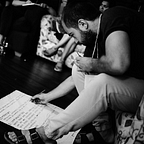The crossroads between play and conflict
In the moments of a conflict that feel the most intractable, the secret tool of play awaits to help transform the situation and bring new solutions to light.
This statement may seem unlikely as the states of play and conflict seem to be worlds apart. Let me explain.
Anyone who has ever been in a conflict knows the difficult cocktail that arises. Emotionally, we may feel angry, scared, vengeful, defensive, confused, helpful, sad, defeated or some mix thereof. Attached to these emotions come a variety of interests, some more or less benevolent: prove that we’re right, make the other person understand how hurt we are, get our way, etc.
Play on the other hand is a delightful space of liberty and psychological safety where we are free to explore and share in pleasure.
So, by integrating the play into the conflict, we immediately are challenging our habitual conflict strategies and inviting ourselves into a new pattern of interaction. It is though we are short circuiting a habitual serious-judgmental-win/lose stance through the innate playfulness that we can all access.
To get you started, here are a few techniques to try out in both interpersonal and team contexts. I am using the word conflict partner as you are both dancing together in the same conflict. The common thread here is not needing to take ourselves so seriously, bringing a breath of fresh air to the interaction!
AMPLIFY YOUR POSITION
Take whatever it is that you are saying and, with your conflict partner, amplify both the message and the emotion. This will help you feel what is at the core of your message and start a conversation at a deeper level of honesty. Additionally, by expanding the emotion instead of contracting it, additional avenues for transformation are opened.
E.g.
I’m upset because you didn’t invite me to the mall on the weekend with our friends.
becomes:
I am absolutely furious because you deliberately excluded me this past weekend when you didn’t invite me. You left me alone…ALONE!!! I bet if you were going on a vacation to the best place in the world with a free ticket, you wouldn’t even consider inviting me.
TAKE TURNS SWITCHING ROLES
After some active listening, simply switch roles with your partner, i.e. pretend that you have become them and are now defending their position. Feel free to amplify their perspectives to reflect how you have understood them.
MODIFY YOUR APPEARANCE
- Continue expressing your arguments with your teeth over your lips, like a rabbit.
- Squish your face together with your two hands.
- Find a ridiculous hat.
Then, continue the conversation as seriously as possible.
VENTING
Each person has 5 minutes to vent. You can say whatever you want, the idea is to let everything out that needs to be said. The other person simply listens with the intention to understand.
GIBBERISH
Continue the conflict for a little bit in gibberish before continuing to your language of choice. While in gibberish mode, try to continue working on strong listening.
DRAW EACH OTHER AS A MONSTER
Draw the other as a monster in a way that shows how you are experiencing their behaviour. Explain to them the attributes of the monster and what they represent.
MIME OUT YOUR EMOTIONS TO A SONG
Find a song that represents how you feel in the conflict. Play the song and mime out the lyrics or the emotion that you associate with the song.
DEBATE
Get a trusted third party to hear your grievances using a debate formula, complete with rebuttals. It is agreed that whatever verdict and corresponding actions the judge determines will be followed by you and your conflict partner.
WRITE A LETTER
In the first section, write why you think your conflict partner is wrong. In the second section, write why you think your conflict partner is right. Share your letters.
CONFLICT CLEANING
Continue having the conflict, and while you argue, put your additional energy into cleaning together.
HIGH FIVES
Every time your conflict partner makes a good point, give them a high five. This reminds you that you are both working on moving forward together.
PUPPET CONFLICT
Find an object or puppet that represents you well in this moment. Continue the conflict through the puppets. Feel free to change their voices as you see fit. The distance offered by the puppets may allow new perspectives to arise.
THE CALM CHALLENGE
With some conflict partners, you may find there is no willingness to listen, validate your perspective or even care about you. If you find yourself in this unfortunate situation, you can explore a fascinating solo game where the only objective is for you to stay light and calm while engaging with this difficult conflict partner. They insult you ? Don’t listen to you? Aren’t being kind ? Simply remember that their behaviour is not about you, and keep playing the game, unbeknownst to anyone but yourself. Of course, as with any game, feel free to disengage the moment you don’t want to be in the interaction anymore.
***
By exploring these playful conflict strategies, or by inventing your own, we can slowly lighten our experience of conflict. We might just learn to enjoy being in conflict together through integrating our creativity and re-imagining our relational patterns ✨.
